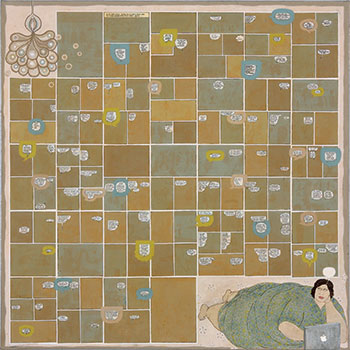
The concept of ‘black humour’ as a distinct genre in modern literature, film and art was invented by the French, with Andre Breton laying claim to its paternity in his Anthology of Black Humour (1997). Moving through texts by Swift, Sade, Poe, Baudelaire, and Lewis Carroll to Lautréamont, Jarry, Kafka, Duchamp and many others, through the choice of the texts in this anthology, Breton makes the connections between narrative form and a dark socio-political vision that have over time become the hallmarks of humour noir.
The undercurrents of the distinctly dark, acidic humour in Breton’s collection were also seen in early twentieth century and post-world war cinema, which popularized the notions of absurdity and modernist pessimism so widely that who today could fail to recognise the dark comedy in the worlds of Charlie Chaplin and Buster Keaton, not to mention Monty Python’s Flying Circus and its avatars, the films of Quentin Tarantino or the Coen Brothers, or even such mainstream reality television fare as the Big Brother?
Dhruvi Acharya, known for the barbed humour with which she casts a wry glance at urban society, is an artist whose works must be interpreted within this most pertinent context of black humour. Playing on the comic value inherent in juxtaposing narratives of reality and fantasy alongside a dark vision of contemporary urban life enables her to impose the serious with the humorous in much the same way as defined by Andre Breton.

While probing anxieties about the world she lives in, Dhruvi offers macabre tales, often extrapolated from incidents in her personal life. Tactile, make-believe scenarios allow for authentically assumed comic experiences for us. For instance, in her recent series of works from the exhibition ‘One Life on Earth’, Dhruvi posits her all-female inhabitants in a post-apocalyptic world that she has envisioned where, as a consequence of increasing pollution, there is a shortage of breathable air. To survive, while some carry personal respirators on their backs, or ‘breath-packs’ as the artists refers to them, there are others who have, in fact, been genetically impacted and have mutated. Having sprouted flowers on their heads to help them breathe, the lower bodies of the mutants have become water bags of sorts, perhaps to keep their personal life-giving plants alive. There is a war waged against the mutants.
Amusingly, in this grim scenario, the weapons of war are none other than emblems of fashion and sophistication for the urban woman. Well manicured nails painted a flamboyant red become claws and chic suede boots are made lethal with spikes embedded in their soles.


Dhruvi skilfully adapts the visual dynamism typical to comic book illustration as she continues to lampoon the urban patterns of living. Having studied Applied Arts at Sophia College, Mumbai before receiving her Master’s degree in Fine Arts from Maryland College of Art in Baltimore, she understands the nuances of graphic illustration. Imaginary, absurd scenarios that defy logic are invented. There is a constant metamorphosis of the human body, just as with popular comic book characters, such as Spiderman or the Transformers. Works titled Morphosis, Plant Leg, Grow, Humps or Trunk bring to life caricaturized protagonists that submit to incessant mutations as they acquire new properties to adapt to their realities. Whereas, in Ear, Hairgrow, Vagiplant, or Headless in Jeans, elements of the anatomy are either, redistributed, exaggerated, or entirely eliminated for the desired effect. Inanimate objects are vested with human anatomical elements that upturn their defining qualities. For instance, in order to strip bubbles and flowers of their fragility, they are furnished with teeth.
Along with deadpan gestures and vacuous expressions, speech blurbs and thought bubbles, although invariably empty, abound in order to communicate the mood. She makes use of onomatopoeic words for violence on canvases filled with weapons of mass destruction along with the usual grenades, machetes and pistols. Her canvases depicting violence are the only instance where Dhruvi engages with the contemporary geo-political situation. Worldwide terrorism and its infiltration are brought fully into play through works titled Wham! Kerplonk! Splat! Bam! and Mumbai 11/7.
While on the one hand Dhruvi makes extensive use of elements typical to comic production in a manner well suited to capture the zeitgeist of a generation and respond to the anxieties and fear of our age, on the other, she attacks this very genre by displaying a healthy disregard for received views through this very medium of popular culture. Through a series of her works titled Words Dhruvi questions the clichés and stereotypes pushed by the widely read Indian comic, Amar Chitra Katha.
With the intent of steering women to introspect on how they define their own sense of self in contemporary terms, she appropriates those folklore by the Amar Chitra Katha that have been crucial in defining the image of the ‘Ideal Indian Woman’, such as that of Savitri and Satyavan. She paints frames of the entire narrative onto a canvas, directs the spotlight away from the illustrations by painting over them and focuses on the dialogue by leaving in the speech bubbles. The seemingly innocuous phrases (such as, “All right father! I shall do as you say” or “it is said, a father who does not give his daughter in marriage is a sinner”) insidiously leap out of the canvas, implicating the comic as being sexually subversive. As a final step towards leading us to a logical outgrowth of this age-old, accepted iconography of the ideal Indian woman, Dhruvi places below this painted grid of speech blurbs, an overweight woman – utterly incongruent with the image provided by the folktale – lying on her stomach, perhaps surfing the internet on her Apple Mac notebook.

Dhruvi’s response to the heroines of the Amar Chitra Katha is not to replace them with superwomen but to produce credible, living, urban female alternatives we can identify with. Instead of typecasting them, she paints vignettes from their daily lives, distinguishing the ‘woman on scooter, woman with book and thoughts, woman in cafe’ or even the ‘woman spewing’, for their individuality.
Dhruvi draws on present-day concerns regarding the consumerist culture and the accelerated pace of modernization with no thought to tomorrow, and mediates the crisis of the age by focusing on the dark and dystopian futures for the human condition through her wit and sarcasm. In much the same manner as black humour, she operates with a counter-cultural perspective which renders her oeuvre an invaluable tool for challenging status quo and contesting the values and ideals of its audience.
Endnotes
- Breton, André. Oeuvres Completes II / Anthologie de l’humour noir, p. 863 – 1176. Editions Gallimard, Paris, 1992. (First printed between 1939 and 1945)
- Durozoi, Gérard. History of the Surrealist Movement, The Permanence and Pertinence of Black Humour, p. 387 – 389. The University of Chicago Press, Chicago, 2002.
- Forest, Philippe. André Breton: écrits sur l’art et autres texts, Art Press, issue 347, Jul – Aug 2008.
- Groenstein, Thierry. La Bande Dessinée, Editions Milan, Toulouse, 1996.
- Shahane, Girish. Flower Power in Dystopia – Catalogue essay for the monographic exhibition of Dhruvi Acharya held in galleries Chemould Prescott Road, Mumbai and Nature Morte, New Delhi, 2008.
- Suleiman, Susan Rubin. Surrealist Black Humour: Masculine/Feminine, 2003. www.surrealismcentre.ac.uk
- Susan, Nisha. Slips between the Lip and the Strip: the Amar Chitra Katha, Tehelka Magazine, Vol 5, Issue 33, Aug 2008.














